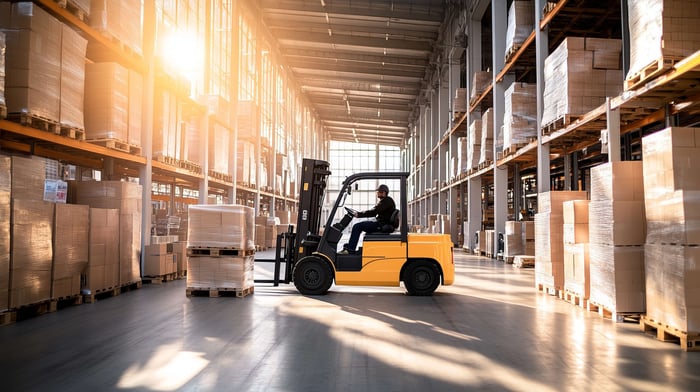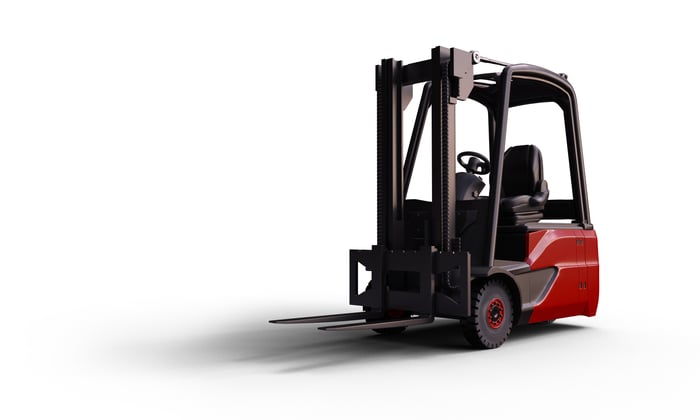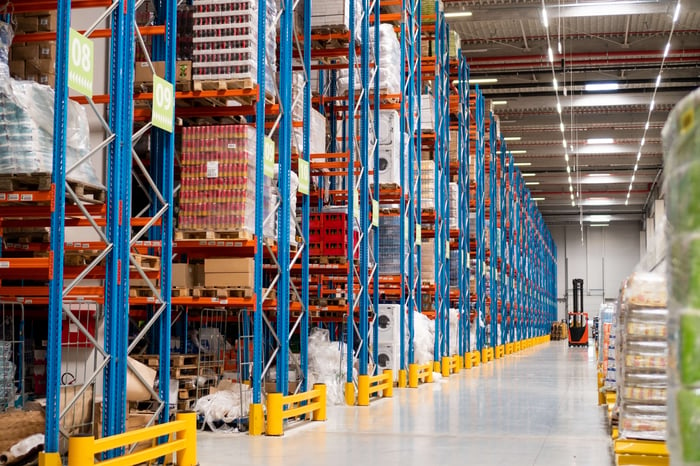No matter the type of goods your warehouse holds in inventory, how you handle the materials is essential for efficiency. That’s where the right material handling equipment for your kind of facility comes in. While there’s a plethora of equipment and tools to support handling materials and goods, they often come with a hefty price.
So, doing your due diligence to ensure it’s a wise investment is key to overall success and ROI.
That’s why we’ve compiled a comprehensive guide on the subject. Here, we’ll cover the most popular equipment types and let you explore their definitions and advantages to see which would be best for your unique operations. Keep reading to learn about the 15 types of material handling equipment you need in your warehouse.
Warehouse Material Handling Equipment: The Top 15
The equipment types here all support a variety of tasks and needs in an operating warehouse. From lifting and transporting to storing and safety, without further ado, here are the top 15 material handling equipment types your warehouse needs.
1. Pallet Jacks
To start our list is a piece you can find in almost any warehouse. Pallet jacks are fundamental for transporting heavy materials, especially stacked on pallets. Their design offers operators twin forks that seamlessly slide beneath the pallet. From there, their hydraulics efficiently lift and move heavy loads while requiring minimal operator effort.
2. Hand Trucks
Another essential type of equipment is hand trucks, which offer a different approach to moving materials than pallet jacks. These devices have a metal frame with a toe plate and handles, making them ideal for smaller objects versus pallets. The operator of the truck simply slides the toe plate under the load and then tilts the handles back to distribute the weight for easy transport evenly.
Wondering which is right for you? Hand trucks don't use hydraulic systems, unlike pallet jacks, making them more suitable for lighter loads.
3. Order Picker Forklift
An order picker forklift has the power to enhance warehouse efficiency by lifting employees and operators to the level where inventory is stored. This design eliminates the need for repeated ladder use, significantly reducing the labor needed to move the ladder from space to space. In addition to improving safety even with heightened productivity.
The ability to bring the operator directly to the picking level makes this equipment especially valuable in facilities with vertical storage systems.
4. Side Loader Forklift
Another type of forklift that’s one of the best pieces of material handling equipment is side loader forklifts. These types of forklifts excel in narrow aisle environments where space optimization is crucial. They can be operated from either a seated or standing position and offer versatility in power sources, too, coming in either electric, diesel, or propane-fueled options.
While they may sacrifice some maneuverability compared to standard forklifts, their ability to operate in confined spaces makes them invaluable for specific warehouse layouts.
5. Automated Guided Vehicles (AGVs)
AGVs are at the forefront of warehouse automation, providing autonomous material handling solutions. These vehicles come in several specialized forms:
Automated guided carts (AGCs) for basic transport needs
Forklift AGVs that replicate human-operated forklift functions
Towing AGVs for long-distance, heavy load transport
Unit Load Handlers for single-unit transport
Heavy Burden Carriers for large assembly operations
Autonomous Mobile Robots (AMRs) with advanced navigation capabilities
6. Cranes
Depending on your inventory type, warehouse cranes can also be highly beneficial. They come in several configurations that meet various needs including:
Bridge cranes span between runway tracks for three-axis movement of heavy loads
Jib cranes offer stationary lifting with a wall-mounted boom
Gantry cranes provide flexible movement along wheel-mounted frames
7. Platform Trucks
If it’s simplicity and versatility you’re looking for, then the basic design of platform trucks could be the right piece of equipment for you. These trucks offer a flat metal surface mounted on wheels with a handle for manual operation. Despite their simple design, these trucks can handle impressive loads exceeding 2,500 lbs when used properly. Proper pushing technique is essential to prevent load displacement and potential accidents.
8. Conveyor Belts
Not surprisingly, conveyor belts form the backbone of many warehouse transport systems. These motor-driven belts efficiently move items along predetermined paths, creating smooth material flow throughout the facility. Their continuous operation capabilities make them ideal for high-volume operations.
9. Reclaimers
Another must-have when it comes to moving materials throughout your warehouse are reclaimers. Reclaimers play an especially crucial role in conveyor systems by gathering and returning loose items to the main belt. Their rotating scoop design ensures efficient material recovery and system continuity.
10. Hoppers
Hoppers utilize gravity for efficient material handling, particularly for loose items. Their funnel-like design facilitates smooth material flow, making them especially valuable in waste management and recycling operations. Advanced models may include automated dumping capabilities.
11. Bucket Elevators
Also known as grain legs, bucket elevators specialize in vertical material transport. Using a series of buckets attached to a belt system, they can efficiently move materials upward, either through manual operation or motorized power.
12. Silos
Silos provide crucial storage solutions for various materials, from agricultural products to industrial materials. Their design offers protection from environmental factors while maintaining material quality and accessibility.
13. Personal Protective Equipment (PPE)
When you’re handling a wide variety of materials and doing so at different heights and motions…safety is crucial. Proper personal protective equipment, or PPE, is a must in any warehouse environment for worker safety. This includes hard hats, masks, gloves, and protective clothing designed to protect against workplace hazards.
14. Safety Swing Gates
OSHA regulation 1910.23 requires proper protection for floor openings and platforms. Adjustable swing gates with universal mounting systems provide versatile protection solutions while meeting safety requirements.
15. Industrial Stairs and Handrails
To reach certain levels of materials, stairs are necessary, as are handrails to protect the workers going up and down them. So, any system using industrial stairs and handrails should follow OSHA requirements, which include:
Slip-resistant decking
Portable aluminum safety railing systems (maintained at 42" height per OSHA requirements)
To create a safe environment for elevated work areas. These systems should be easily installable and move when needed while providing robust fall protection.
Safety and Compliance Considerations
Keep in mind that OSHA standards must still be met with any type of equipment you add to your fleet. According to OSHA, standards require fall protection at elevations of four feet or higher and when working over dangerous equipment, regardless of height.
Additionally, all PPE must meet or exceed ANSI standards. Regular equipment maintenance, proper training, and consistent safety protocol enforcement are essential for maintaining a safe warehouse environment.
The Final Word: Material Handling Equipment
Now that you know the top 15 material handling equipment that warehouses use for safety, transporting, lifting, and storing, it’s time to find a trusted partner to procure the right type for you. Look no further than the material handling experts at BMH. BMH is one of the fastest-growing companies in the material handling space, having grown 732% year-over-year in 2022.
Our team supports warehouse operators and managers in finding the right products for their inventory needs, warehouse design, installation services, and beyond. We even offer crane inspections and forklift maintenance to support your selected equipment.
Ready to take your warehouse operations to the next level? Get in touch with a BMH location near you to learn more.




